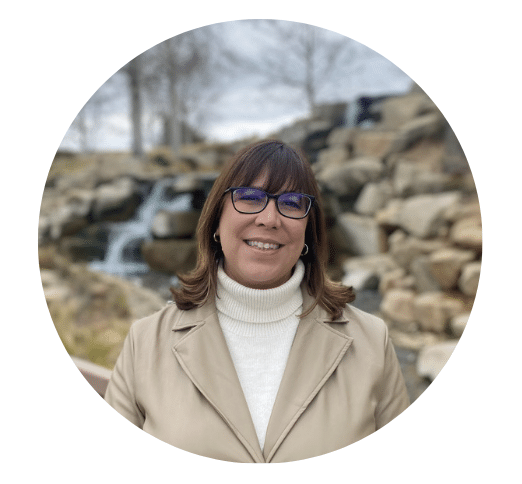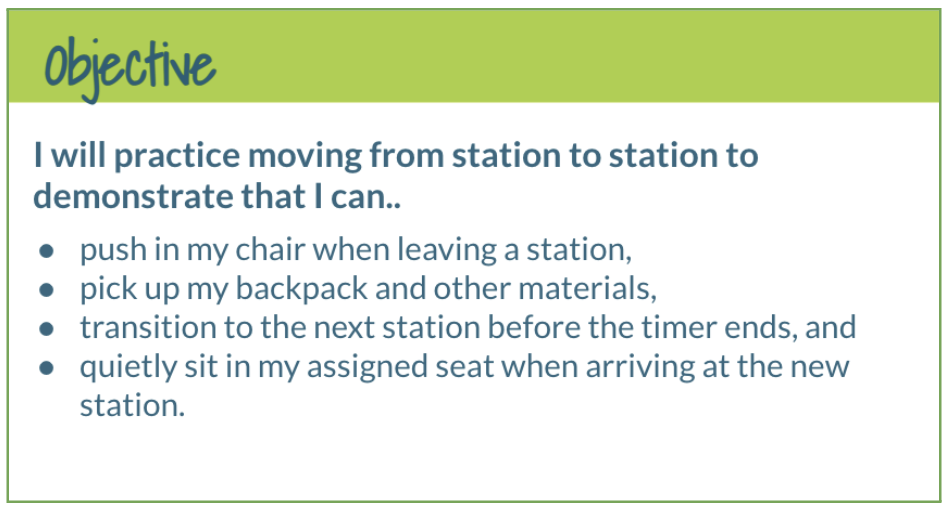
Don’t let transitions steal class time!
Some classes understand the expectations of the station rotation model almost immediately. The teacher explains the model, the students understand the expectations, and the class moves into stations smoothly. Other classes need a little more practice before fully implementing the station rotation model. When introducing station rotation, I encourage teachers to embrace a couple of routines to make the experience run more smoothly.
Practice Moving from Station to Station
The first time I introduce station rotation, I take a few minutes to explain what station rotation is and the purpose behind it. Then, I have students practice moving from station to station.
I point to each station’s location and review the assigned seating chart. That way, students know what station to report to after each transition and where to sit during the independent and student-led collaborative stations. (Note: I don’t usually assign seats at the independent teacher-led station because that is where I will be.)
Review the Objective
Then, I project the objective of our practice session and clearly review the expectations.
Once students understand the objective, they practice moving from station to station. Because students do not need to get out any materials when they transition, I set the transition timer to 20 seconds. Once everyone is seated in their new station, I refer to the assigned seating chart to ensure students sit in the correct seats at the student-led collaboration and independent stations.
I usually have students practice moving through the entire station rotation two or three times, depending on the needs of the students in the class. You will see improvement between each practice round.
After students have completed moving through the station rotation, I post these self-reflection questions for students to think about and discuss with a partner:
- On a scale of 1-5 (five being the highest), how well do you think the class did when moving from station to station? Explain why you gave this score.
- On a scale of 1-5 (five being the highest), how well do you think you did when moving from station to station? Do you feel that you met the objectives? Provide evidence to support your score.
Practice Reading or Watching Station Directions
One of the challenges that teachers encounter when first implementing station rotation is that students don’t read the station directions at the independent and student-led collaborative stations. As a result, students can take a long time to get on task or bombard the teacher with questions, making it challenging for the teacher to facilitate their station.
To help address this, I encourage teachers to have students practice the station rotation model again but add additional bullets to the objective, so that students know they are expected to read/listen to and follow the directions at each station.
When implementing this next practice round, I set out the written directions and any necessary materials needed for each station. Then I set the transition timer and instruct students to move to their first station. Once students are seated, I set the timer for 8-10 minutes. I meet with the teacher-led small group and verbally explain my instructions to the students there. I check for understanding. Then I walk around to ensure the students at the other stations are reading and following the station directions.
Teachers working with younger students may want to use video directions instead of text-based directions. In that situation, it is still important to have students practice accessing the video directions, playing them, and practicing pausing or restarting the video. That way, even young learners can get the instructions they need.
Onboard Students with SEL-focused Activities
Because this is the first time students practice reading and following directions at the independent and student-led collaborative stations, the task of each station is SEL-focused, not content focused. For example, the kids at the student-led collaborative station tables draw cards and discuss questions. What is your favorite movie? If you could travel to any location, where would you go and why?
Students at the independent station are directed to log into Google Classroom, put on headphones, and play a breathing exercise/meditation video. This breathing activity reinforces the norm that students will work quietly on their own at the independent station.
Students at the teacher-led small group station log in to their computers and fill out a Google Form. It contains questions like, What do you want your teacher knows about your learning preferences? How do you think small group instruction can help you?
After students complete the full station rotation, I again provide reflection questions. This time I have them reflect individually on a Google Form.
- How well did you follow directions during the independent station? Explain your answer.
- How well did your team follow directions during the student-led collaborative station? Explain your answer.
- What station do you think you will like the most? Explain your answer.
- What advice do you have for me, the teacher, when we start to fully implement station rotation?
Having students reflect upon their station rotation practice is a great way to gauge how students feel about the model. Through student feedback, I have improved my stations to help meet individual needs.
Additional Helpful Tips
- When implementing station rotation, teachers should not spend the first 10-15 minutes of class verbally reviewing directions. That is valuable learning time. Students tend to forget most of what their teachers say as soon as they move into stations. When students practice reading directions, it minimizes the “What are we supposed to be doing?” questions and helps students get on-task quickly.
- Timers are an essential component of smooth transitions from station to station. When station rotation is fully implemented, it should take students about 60 seconds to transition. This should provide students enough time to pack up, move to another station, and get materials ready for the new station.
When you first implement the station rotation model, taking a little time to have students practice it makes a big difference the rest of the year.
Stay tuned for more simple but helpful tips about station rotation! You can also check out this post on frequently asked questions about the station rotation model.
R. Noelle Gutierrez has been working in public education for almost twenty years. She spent eleven years teaching English Language Arts and History at the middle school level. She then worked as an Instructional Coach for seven years, training and coaching secondary teachers in student engagement, standard-based strategies, curriculum development, and blended learning. During her time as an Instructional Coach, Noelle developed resources for Smarter Balanced. Noelle is currently working as a middle school Assistant Principal, where she continues to coach and train teachers.








4 Responses
I used to just assume that students knew how to rotate and read directions but I never assume anything anymore. Practicing the procedure and teaching the expectations is key. Great post! Thanks for sharing.
You’re welcome, Sharon!
Hello Catlin!
I absolutely love the way you formatted your learning objective. What is it called? How would you format your learning objective according to a different teaching methodologies (i.e. independent work, socratic seminar, mini-lectures, stations)?
Hi Valerie,
When writing a learning objective, the goal is to articulate what students will be able to understand or do at the end of a learning experience. So, if the learning objective is focused on independent work, it might read, “By the end of this independent learning station activity, you will be able to solve basic algebraic equations involving one variable.” The specific wording will be informed by the focus of the learning activity and the standard students are working on.
I hope that helps!
Catlin